The majority of Old World succulent monocotyledons are grouped into the Aloaceae, a medium sized family of rosulate leaf succulents including Aloe, Astroloba, Bulbine, Chortolirion, Gasteria, Haworthia and Poellnitzia. The largest genus is Aloe with more than 400 species. The Aloaceae are distributed across southern Africa, Arabia, Madagascar and the Mascarene Islands. A few Bulbines are found in Australia.
|
Bulbine Wolf 1776
Name: Latin bulbus = bulb
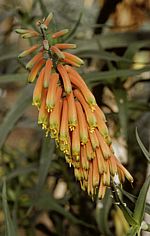
This variable genus includes about 80 species of succulent perrennial herbs or geophytes with deciduous succulent leaves that die back annualy and basal tubers or rhyzomes. Star-shaped flowers with 6 petals are generally yellow, or orange in a few species, and readily distinguished by their bearded (hairy) stamen filaments.
Most species of Bulbine are from Southern Africa, especially the South-Western Cape area. Six species are native to Australia. Bulbine frutescens is grown as xerophyic ground cover plant in Southern Africa and the South-western USA and is reported to tolerate a light frost. Its succulent leaves have been used medicinally in a similar way to those of Aloe vera. The juice of Bulbine annua, B. lagopus is said to have antibacterial and antifungal properties when applied externally. Medicinal use of Bulbines is not recommended here. Some species of Bulbine have toxic foliage (e.g. Bulbine bulbosa, Australia) especially to livestock, although the tubers of this and other species are roasted and eaten by bushmen.
Click on the pictures below for a higher quality image.
|
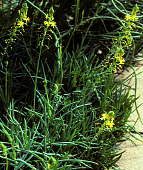 |
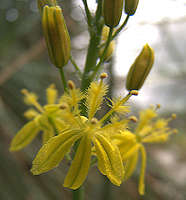 |
Bulbine frutescens
Native to South Africa.
|
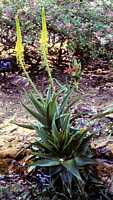 |
 |
Bulbine latifolia (Rooiwortel)
Native to South Africa.
|
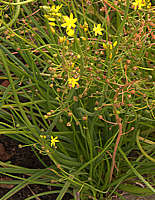 |
 |
Bulbine semibarbata
Native to Australia.
|
Bulbinella Kunth 1843
Bulbinella is a genus of 23 species of non succulent plants with tuberous roots and fine or narrow leaves up to 3 ft long. Most species (16) are from the winter rainfall region of South Africa with a few species from central New Zealand. The inflorescence is a dense raceme of white, yellow, orange or pink star-shaped flowers with six petals and stamens. The stamens are simple filaments, unlike the bearded stamens of Bulbine. The seeds have a characteristic shield shape and occur in pairs. Flowers are produced in late Winter or early Spring.
The genus Bulbinella is often confused with the succulent genus Bulbine. If in doubt, check the stamens.
|
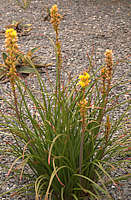 |
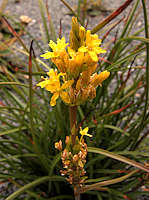 |
 |
|
Bulbinella hookeri Colenso ex Hooker 1906 (Maori Onion)
a non-succulent plant from New Zealand with lax, narrow 2ft leaves which are inrolled to form a channel. Spikes of bright yellow flowers are produced through the Summer. The 6 stamens have simple filaments.
A moderately hardy plant, requiring moist but not waterlogged soil.
|

 Families of Succulent Plants
Families of Succulent Plants The Aloe Page
The Aloe Page 


 Families of Succulent Plants
Families of Succulent Plants The Aloe Page
The Aloe Page 
